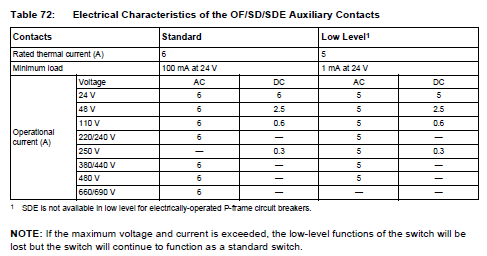Search FAQs
What is the function and electrical characteristics of the auxiliary switch, alarm switch, and overcurrent trip switch for the PowerPact H, J, L, M, P, R, and NS630b - NS3200 electronic trip circuit breakers?
Issue:
What is the function and electrical characteristics of the auxiliary switch, alarm switch, and overcurrent trip switch for the PowerPact H, J, L, M, P, R, and NS630b - NS3200 electronic trip circuit breakers?
Product Line:
PowerPact and Masterpact breakers
Resolution:
AUXILIARY SWITCH (OF)
An auxiliary switch is a single pole, double throw switch operated by the movable contact arm assembly. It is used to remotely indicate the position of the main circuit breaker contacts, whether open or closed.
ALARM SWITCH (SD)
An alarm switch indicates that the circuit breaker has tripped due to an overload, short circuit, or ground fault, the operation of a shunt trip or undervoltage trip, or the push-to-trip button. The alarm switch resets when the circuit breaker is reset.
OVERCURRENT TRIP SWTCH (SDE)
An overcurrent trip switch indicates that the circuit breaker has tripped due to an overload, short circuit, or ground fault. The overcurrent trip switch resets when the circuit breaker is reset.
These switches are available in low level versions (with gold flash plating) capable of switching very low loads (e.g. for controlling PLCs or electronic circuits).

What is the function and electrical characteristics of the auxiliary switch, alarm switch, and overcurrent trip switch for the PowerPact H, J, L, M, P, R, and NS630b - NS3200 electronic trip circuit breakers?
Product Line:
PowerPact and Masterpact breakers
Resolution:
AUXILIARY SWITCH (OF)
An auxiliary switch is a single pole, double throw switch operated by the movable contact arm assembly. It is used to remotely indicate the position of the main circuit breaker contacts, whether open or closed.
ALARM SWITCH (SD)
An alarm switch indicates that the circuit breaker has tripped due to an overload, short circuit, or ground fault, the operation of a shunt trip or undervoltage trip, or the push-to-trip button. The alarm switch resets when the circuit breaker is reset.
OVERCURRENT TRIP SWTCH (SDE)
An overcurrent trip switch indicates that the circuit breaker has tripped due to an overload, short circuit, or ground fault. The overcurrent trip switch resets when the circuit breaker is reset.
These switches are available in low level versions (with gold flash plating) capable of switching very low loads (e.g. for controlling PLCs or electronic circuits).
Released for:Schneider Electric New Zealand
Explore more
Range:


Explore more
Range:



